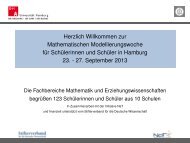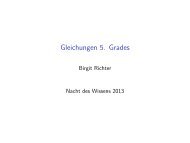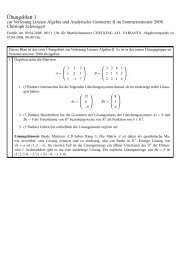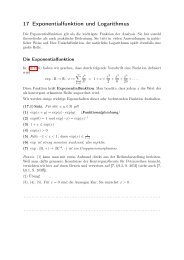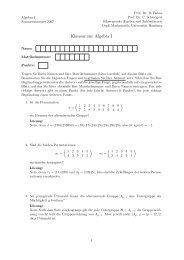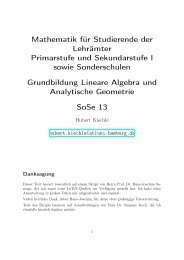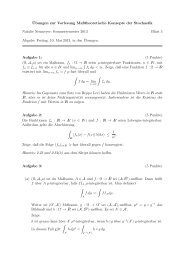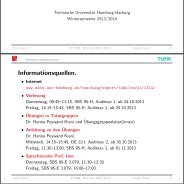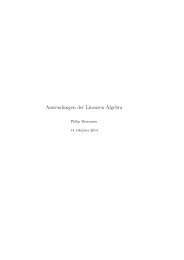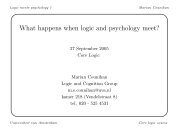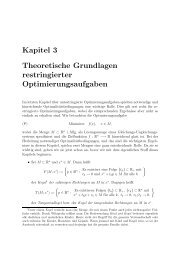pdf file
pdf file
pdf file
You also want an ePaper? Increase the reach of your titles
YUMPU automatically turns print PDFs into web optimized ePapers that Google loves.
Proof.<br />
One can show that any tangle can be decomposed into the building blocks listed above. One<br />
then has to show the compatibility of F with the Reidemeister moves. This follows from the<br />
axioms of a ribbon category.<br />
✷<br />
Remarks 5.3.15.<br />
• In particular, restricting to morphisms between the tensor unit, we get an invariant of<br />
C-coloured framed oriented links in S 3 :<br />
F (L) ∈ End(I) .<br />
Since F is a monoidal functor, this invariant is multiplicative, F (L ⊗ L ′ ) = F (L) ⊗ F (L ′ ).<br />
• For the special case of the unknot labelled by the object V ∈<br />
dim V ∈ End C (I).<br />
C, we get the invariant<br />
The following generalization will be needed in the construction of topological field theories:<br />
Observation 5.3.16.<br />
1. We define a functor C ⊠n → vect by<br />
(V 1 , . . . , V n ) ↦→ Hom C (I, V 1 ⊗ ∙ ∙ ∙ ⊗ V n ) (14)<br />
for any collection V 1 , . . . , V n of objects of C. We thus consider invariant tensors in the<br />
tensor product. The pivotal structure gives functorial isomorphisms<br />
z : Hom C (I, V 1 ⊗ ∙ ∙ ∙ ⊗ V n ) ∼ = Hom C (I, V n ⊗ V 1 ⊗ ∙ ∙ ∙ ⊗ V n−1 ) (15)<br />
such that z n = id; thus, up to a canonical isomorphism, the space Hom C (I, V 1 ⊗ ∙ ∙ ∙ ⊗ V n )<br />
only depends on the cyclic order of the objects V 1 , . . . , V n .<br />
2. For a spherical category, we can define invariants of tangles where no crossings are allowed<br />
in the diagrams. We can also do the more general construction: consider an oriented graph<br />
Γ embedded in the sphere S 2 , where each edge e is colored by an object V (e) ∈ C, and each<br />
vertex v is colored by a morphism ϕ v ∈ Hom C (I, V (e 1 ) ± ⊗ ∙ ∙ ∙ ⊗ V (e n ) ± ), where e 1 , . . . , e n<br />
are the edges adjacent to vertex v, taken in clockwise order, and V (e i ) ± = V (e i ) if e i is<br />
outgoing edge, and V ∗ (e i ) if e i is the incoming edge.<br />
By removing a point from S 2 and identifying S 2 \ pt ≃ R 2 , we can consider Γ as a planar<br />
graph to which our rules assign a number Z(Γ) ∈ K. One shows that this number is an<br />
invariant of coloured graphs on the sphere.<br />
3. Note that up to this point, only graphs on S 2 without crossings were allowed. We generalize<br />
this setup by allowing finitely many non-intersecting edges of a different type, labelled<br />
by objects of the Drinfeld double Z(C). These edges are supposed to start and end at the<br />
vertices as well. We colour edges of such a graph ˆΓ with objects in C and Z(C) respectively<br />
and morphisms as before. We get an invariant Z(Γ) ∈ K for this type of graph as well.<br />
133




